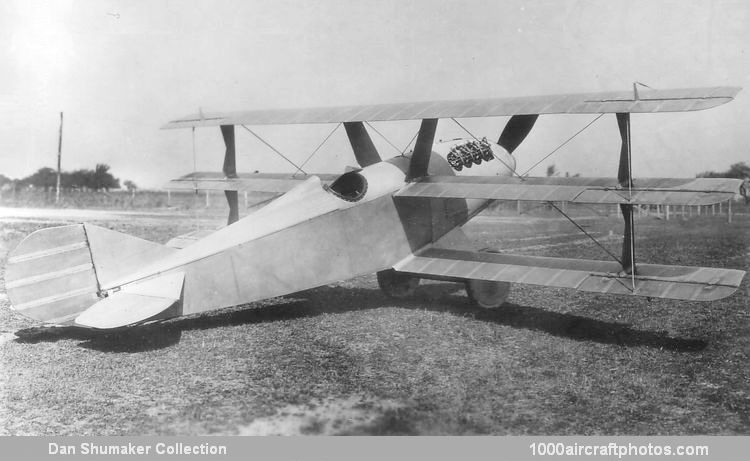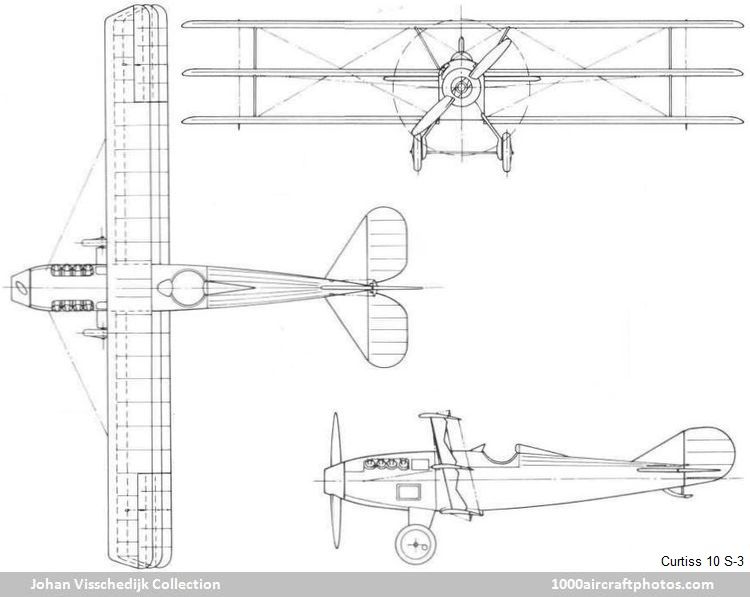09/30/2011. Remarks by Johan Visschedijk: "Curtiss developed seven different Scout models in its S-series (S, S-1 to S-6, the latter four of which were retrospectively designated Model 10 to 10C) of 1916-1917, but succeeded in selling only a few to the USASC and USN. The inadequacy of these aeroplanes cannot be blamed on lack of skill among the Curtiss designers; rather, it showed how far the US aviation industry had fallen behind that of Europe, which was operating under the immediate requirements of the European war. American designers were almost completely cut off from the latest European advances and had to progress from the 1914 designs on their own without the stimulus and large scale financing of a war economy.
S
The first Model S of 1916 was built to the concepts of what European builders had called a Scout in 1914. This was a single-seat tractor biplane originally used for the work its name implied-the scouting of enemy activity. Early scouts were unarmed but new designs were soon fitted with fixed forward-firing machine guns; even though they then became fighters or pursuit planes, the term Scout stuck to the single-seaters almost to the end of the war.
S-1 Speed Scout
Also called Baby Scout, the original Model S-1 was the smallest aeroplane that Curtiss could build around the 90 hp OX engine. Construction of the biplane was thoroughly conventional for the time, but the 20 ft (6.09 m) span of the single-bay wings was inadequate. The upper wing was lengthened and braced with diagonal struts. The S-1 did not sell, and Curtiss kept the modified prototype for its own use.
S-2 Wireless
The S-2 was essentially the Model S-1 fitted with new Eiffel 32 airfoil wings and a unique strut arrangement that eliminated the need for conventional wing bracing wires, hence the name Wireless. The problem of fitting shock absorbers in the landing gear when the wing struts were anchored to the ends of the cross-axle was solved by using the new Ackermann spring wheels, which featured curved spokes made of flat spring steel that served that purpose; these wheels did not have good resistance to side loads, unfortunately, and were not widely used.
Power plant 100 hp Curtiss OXX-2. Span (upper) 21 ft 10 in (6.65 m), (lower) 11 ft 3 in (3.42 m). Empty weight 805 lb (365 kg). Max speed 119 mph (191.5 kmh).
S-3 (Model 10)
The only 'production' models of the S-series were four S-3 triplanes sold to the USASC early in 1917 (serial 322 to 325). These used the basic fuselage, engine, and tail of the Sand S-2 fitted with single-bay equal span triplane wings using the RAF 6 airfoil. These were the USASC's first single-seat Scouts, but they were still more than two years behind equivalent European types. The four USASC Curtiss S-3s of early 1917 did not carry guns although they were classified as Scouts, which was synonymous with Pursuit at the time.
Power plant 100 hp Curtiss OXX-3. Span 25 ft (7.62 m); length 19 ft 6 in (5.94 m); height 8 ft 7 in (2.61 m); wing area 142.6 sq.ft (13.24 sq.m). Empty weight 970 lb (440 kg); gross weight 1,320 lb (599 kg). Max speed 115 mph (185 kmh); climb 9,000 ft (2,743 m) in 10 min.
S-4 (Model 10A)
This was a triplane similar to the S-3 intended as a seaplane Scout for the USN, serial A-149. This was Curtiss's first experience with the twin-float configuration. As with other Curtiss seaplanes, it became necessary to increase the span of the S-4 to carry the extra weight. The front float struts collapsed during a heavy alighting in January 1918 and the aircraft was struck off charge.
S-5 (Model 10B)
This was similar to the S-4 except for being fitted with a single main float and small wing tip floats. USN serial A-150, struck off on August 6, 1919.
S-6 (Model 10C)
The S-6 was an improved version of the S-3 and was the first American Scout fitted with twin forward-firing machine guns. This may have been only an inoperative test installation intended to check weight, balance, and location, for the guns were gas-operated Lewis models which were not used for synchronized fire through the propeller. The USASC ordered twelve early in 1917 but only one, serial 492, was delivered."

